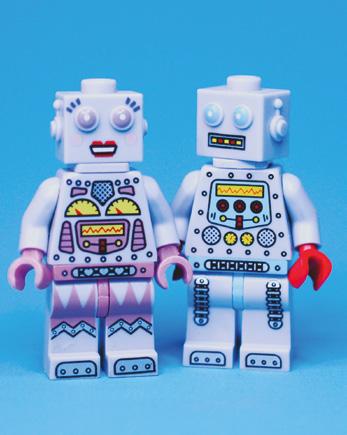
4 minute read
Applying AI to male reproduction Using AI to address skeletal health
Artificial intelligence and male reproduction
Over the past 20 years, the use of artificial intelligence (AI) in medicine has attracted considerable interest, but is there a ‘knowledge gap’ in its application to male reproduction?
Advertisement
In reproductive endocrinology, many trials have applied AI to predict the fertility of women, and the quality of oocytes and blastocysts, as well as decision-making algorithms for ovarian stimulation.
In male reproduction we see fewer studies, with most focusing on the examination of seminal fluid. Several trials have presented image recognition systems for morphological classification of sperm, determining their motility, or selection of gametes with reduced DNA damage for assisted reproduction technique (ART). Although very effective, these tools are not yet found in daily clinical practice and cannot be used in the general population.
Nevertheless, AI can find other targets in the field of male infertility. One interesting approach concerns radiomics. By use of image analysers, we try to make objective ultrasound parameters operator-dependent, for instance regarding the ecostructure and echogenicity of the testicular parenchyma. In a pilot study conducted by the University of Modena, classification of these two parameters on an objective basis using radiomics correlated with semen quality and circulating levels of androgens and gonadotrophins.1 Although preliminary and not yet usable in clinical practice, these data lead the way for new objective parameters, beyond the calculation of testicular volume, for an increasingly widespread and relatively low-cost examination.
With a similar purpose, a predictive model that uses hormonal, clinical and seminal baseline data was developed to predict the outcome of varicocelectomy in terms of improving seminal parameters.2
Another field of application of AI in andrology has been highlighted by researchers at the University of Münster, who have created a predictive model based on machine learning for the identification of patients with Klinefelter syndrome from subjects with idiopathic azoospermia. This predictive model has a sensitivity of 100% and a specificity >93% for the identification of subjects with the 47,XXY karyotype.3 A benchmarking analysis against 18 andrologists experienced in diagnosing and treating subjects with Klinefelter syndrome showed the superiority of this predictive model.
So, while the uses of AI in male fertility almost all address analysis of the characteristics of spermatozoa, especially for ART, the possible uses are many. Use of AI should be aimed at providing tools to improve diagnostic accuracy and predict treatment outcomes.
Settimio D’Andrea
Italy
REFERENCES
1. De Santi et al. 2022 Andrology10 505−517 (https://doi.org/10.1111/andr.13131). 2. Ory et al. 2022 World Journal of Men’s Health40 e14 (https://doi.org/10.5534/wjmh.210159). 3. Krenz et al. 2022 Andrology10 534−544 (https://doi.org/10.1111/andr.13141).
Can AI discover fractures better than humans?
New techniques and software to properly address skeletal health and fragility are in high demand in clinical practice.
Dual X-ray absorptiometry (DXA) is the gold standard for the diagnosis of osteoporosis. However, this method has many technical limitations and the parameters derived by its use need careful interpretation by clinicians.
A multitude of studies are starting to investigate the role of AI models in application to diagnostics in osteoporosis and bone metabolism disorders − some of them are achieving intriguing results.
Radiomics involves the conversion of images to higher dimensional data and the subsequent mining of these data for improved decision support.1 This approach is able to extract many features from traditional medical imaging (computed tomography/magnetic resonance imaging scans) and make these features (e.g. grayscales) available for further processing and analysis. In the setting of osteoporosis, this technique could be crucial in overcoming some of the limitations of DXA and in elucidating the texture and spatial heterogeneity of bone, with potential great improvement in diagnostic accuracy.
8

©IRCCS Humanitas Research Hospital
CT acquisition of lumbar spine with primary osteoporotic verterbal fractures. Automatic identification of vertebral level used 3D Convolutional Neural Network.
One example of its application to osteoporosis is offered by the machine learning model that Rastegar et al. are developing, with promising results.2 They are starting to identify the radiomics/DXA-derived parameters with higher predictive role, for a new and more precise classification of normal bone versus osteopenia/ osteoporosis.
Vertebral fractures (VFs) are considered the hallmark of osteoporosis, yet the correct approach and methodology to investigate and define fragility VFs are still highly debated. Could a computer be as precise as the human eye? Apparently, we are getting closer to this. In a recently published study, Biamonte and colleagues described an AI-based radiomics model using computed tomography-derived images of the lumbar spine, which was able to identify bone textural features independently associated with the presence of VFs, and could also correctly identify and characterise skeletal fragility.3
These are only some of early experiences from the application of highly advanced technologies to the field of bone health, and more work will be necessary before these tools can become part of clinical practice but, clearly, we are on the right track.
The future of AI as clinical aid for the management of bone disease seems to be bright ... or possibly just greyscale.
Walter Vena
Italy
REFERENCES
1. Gillies et al. 2016 Radiology278 563−577 (https://doi.org/10.1148/radiol.2015151169). 2. Rastegar et al. 2020 Diagnostic & Interventional Imaging 101 599−610 (https://10.1016/j.diii.2020.01.008). 3. Biamonte et al. 2022 Journal of Endocrinological Investigation (https://doi.org/10.1007/s40618-022-01837-z).









